November 6, 2014
by Carole Zangari -
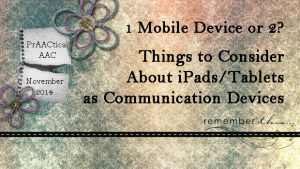
Should iPads and tablets be used both for communication and other things? That’s a question we hear rather frequently these days. Our answer will probably frustrate you. Ready? Here goes: It depends. It depends on the learner. Consider these two students. Tia is 6 and very much a beginning communicator. She has had her mobile device with a core language based AAC app for a few months. Tia uses it independently to ask for a few of her favorite things, like music and bubbles. With prompting she can use it to ask for a wider variety things, and can also use it for commenting, labeling, greeting, and answering ‘what’ questions. She does not yet combine two symbols to make short sentences. Yvette is 15 and has been using AAC since she was a toddler. She uses a text-to-speech app on her mobile device and knows how to program phrases and... [Read More...]
Filed under: PrAACtical Thinking
Tagged With: mobile devices, tablets
November 5, 2014
by Carole Zangari -

There has been a lot of buzz about 3-D printers in the past year, a technology that is teeming with potential for assistive technology lovers. In this video, we look at a joint project by Hereward College and the University of Warwick. This is a win-win for the AT users and the students at these universities who are learning prAACtical ways to support people with disabilities. Very prAACtical! https://www.youtube.com/watch?v=N_-sVw_hQ5k
Filed under: PrAACtical Thinking
Tagged With: 3-D printer, assistive technology
November 4, 2014
by Carole Zangari -

In one of my AAC classes, we’ve been talking about working collaboratively with vendors of SGDs and other AT in a way that is ethically responsible. Clearly, we look first to our ASHA SLP Code of Conduct, best practices, agency policies and procedures, and regulations (such as HIPAA and FERPA in the US). Secondly, we use a feature match process to guide the evaluation so that there is appropriate diversity in the communications being considered. Beyond that, here are some of the things we came up with. Open a dialogue and the roles and expectations of each party. If we are inviting a vendor in to provide some support, then it’s best to precede that with a frank conversation so that everyone is clear on how to proceed. Be clear about acceptable and unacceptable behaviors prior to the start of the collaborative activity. Having some guidelines written out in advance... [Read More...]
Filed under: PrAACtical Thinking
Tagged With: assessment, ethics, SGD, vendor
November 1, 2014
by Carole Zangari -
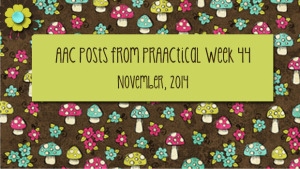
Sunday: Video of the Week – Core Vocabulary in Activity-based Intervention Tuesday: Teach Me Tuesday – Dynavox V/VMax Wednesday: Now It’s Your Turn Thursday: AAC Assessment Forms Friday: The Faces of AAC – Paula and Brian
Filed under: PrAACtical Thinking
October 31, 2014
by Carole Zangari -
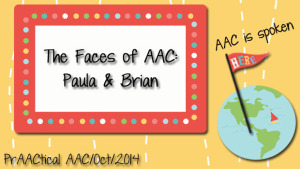
As we bring AAC Awareness Month to close, we add add another Face of AAC. Dianna Finlay, an SLP from CLASS in Tacoma Washington and Clinic Director Paula Herrington, introduce us to Brian. :::::::::::::::::::::::::::::::::::::: Brian Long. He’s a user. He’s been using all his life. He likes the high. I can’t say I blame him. One of Brian’s buddies was a user for a while. He stopped using and is still going though bad withdrawal. If I was dealt the same hand as Brian, I’d like to think I’d be a user too. Of course, we’re talking about a user of augmentative and alternative communication. Brian Long is a 43-‐year-‐old male diagnosed with cerebral palsy. He has no functional oral speech and depends on a speech-‐generating device to communicate. Brian has been receiving speech therapy through CLASS, Inc. for a few years now. He communicates via a Dynavox Vmax, however, the device sat in... [Read More...]
Filed under: PrAACtical Thinking
Tagged With: Brian Long, Faces of AAC, Paula Herrington
October 30, 2014
by Carole Zangari -
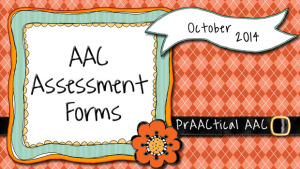
One of the challenging things about teaching graduate student SLPs to do AAC assessments is that there is no single, comprehensive protocol to cover the needs of all types of clients. We’ve started a collection of forms and thought some of you might find them helpful. If you know of others, please get in touch so we can add to the list. That way we’ll have them all in one place. Intake and General AAC Assessment AAC Assessment Protocol: Gail Van Tatenhove AAC Checklist and Rubric: Tufte AAC Intervention Rubric: Angela Standridge, Texas Region 4 Education Service Center Adult Pre-Assessment (Acquired Disabilities): Gail Van Tatenhove Adult Pre-Assessment (Congenital Disabilities): Gail Van Tatenhove Bloom and Lahey-Early Communicative Forms and Functions: Exceptional Children Division, NC Department of Public Instruction Dynamic Assistive Technology Evaluation (DATE) Collaborative Worksheet: Texas AT Network Needs Assessment: Gail Van Tatenhove Pediatric Pre-Assessment: Gail Van Tatenhove Picture Assessment: Gail... [Read More...]
Filed under: PrAACtical Thinking
Tagged With: AAC assessment, assessment, assessment form
October 29, 2014
by Carole Zangari -

Today, we’re back to Poland to watch a terrific video inspired by Pat Mervine’s wonderful book, How Katie Got a Voice. It’s a perfect blend of AAC awareness-building, story-telling, and prAACtical inspiration. Enjoy this wonderful story!
Filed under: PrAACtical Thinking
Tagged With: awareness, kids, Pat Mervine, Poland
October 28, 2014
by Carole Zangari -

Need to learn more about the VMax+ from DynaVox? Welcome to the V and VMax Video Getting Started with the V and VMax Video V and VMax Basics Video Understanding InterAACt Video V/VMax Quick Start Guide Series 5 User Guide Series 5 Training Manual Series 5 Full Manual InterAACt Guide Where to Go for Help: Search the Knowledge Base, Live Chat, Phone (800-588-4548)
Filed under: PrAACtical Thinking
Tagged With: Dynavox, Teach Me Tuesday, VMax+
October 25, 2014
by Carole Zangari -
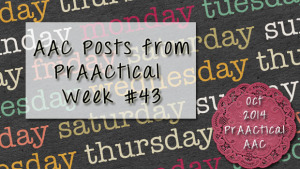
Sunday: Video of the Week – Getting Started with AAC Assessment Tuesday: Teach Me Tuesday – iAssist Communicator Wednesday: Global Day of AAC Thursday: How I Do It by Rachael Langley – PODD in the Classroom: Portable, Wearable, & Comfortable Friday: 5 Things that (Should) Guide SLPs in the Practice of AAC
Filed under: PrAACtical Thinking
October 24, 2014
by Carole Zangari -
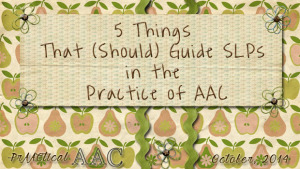
Providing good AAC services is messy stuff. To start with, language therapy can’t be tied up into neat little packages. Add in motor skills, symbolization, perceptual abilities, the technology, and all the rest of it and you can see why SLPs new to AAC get overwhelmed. Here are some resources we turn to when trying to blaze a path to communicative competence with our AAC friends. ASHA’s Roles and Responsibilities of SLPs with Respect to AAC National Joint Committee (NJC) Position Statement on Eligibility to Communication Services Developmental Patterns for Syntax and Morphology Data from a Comprehensive AAC Assessment ASHA Code of Ethics
Filed under: PrAACtical Thinking









